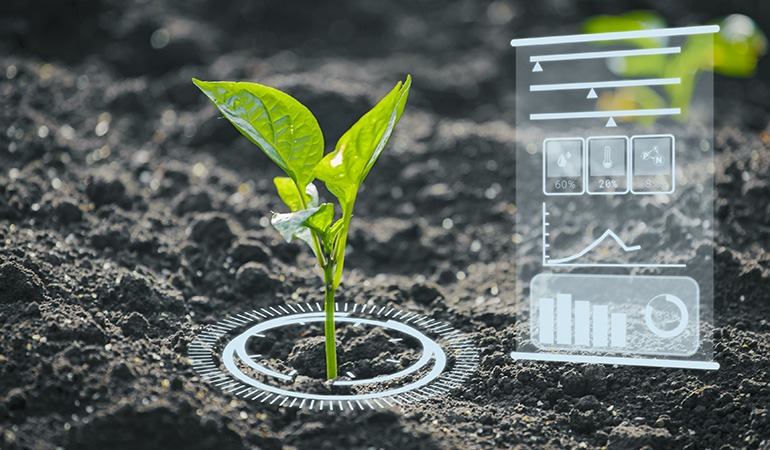Introduction
Agriculture has always been at the heart of human civilization, serving as the primary source of food, fiber, and fuel. However, with a rapidly growing global population and the impacts of climate change, traditional farming practices are being pushed to their limits. Enter artificial intelligence (AI), a transformative technology that promises to revolutionize agriculture. This analysis delves into how AI is reshaping agriculture, the benefits and challenges it presents, and its potential to sustainably feed the future.
The Role of AI in Agriculture
AI in agriculture encompasses a broad range of technologies and applications designed to optimize farming practices. These include machine learning, computer vision, robotics, and predictive analytics. AI’s integration into agriculture aims to enhance productivity, reduce environmental impact, and ensure food security.
- Precision Farming
Precision farming is perhaps the most significant application of AI in agriculture. It involves the use of AI-driven tools and sensors to collect and analyze data on soil conditions, weather patterns, crop health, and pest infestations. This data-driven approach allows farmers to make informed decisions, applying resources like water, fertilizers, and pesticides only where needed, thereby increasing efficiency and reducing waste.
- Predictive Analytics
AI-powered predictive analytics help farmers forecast crop yields, weather events, and market trends. By analyzing historical data and current conditions, AI can predict potential problems before they arise, enabling farmers to take proactive measures. For example, predicting droughts or pest outbreaks can help farmers mitigate risks and plan accordingly.
- Automated Machinery
Robotics and automated machinery, guided by AI, are revolutionizing labor-intensive tasks. Autonomous tractors, drones, and harvesters can perform tasks such as planting, watering, weeding, and harvesting with high precision and minimal human intervention. These machines not only increase efficiency but also address labor shortages, a common issue in many agricultural sectors.
- Crop Monitoring and Management
AI technologies, particularly computer vision, enable detailed monitoring of crop health. High-resolution images captured by drones or satellites are analyzed to detect signs of disease, nutrient deficiencies, or pest damage. This early detection system allows for timely interventions, potentially saving entire crops from failure.
Benefits of AI in Agriculture
The adoption of AI in agriculture offers numerous benefits, which can be broadly categorized into increased productivity, sustainability, and profitability.
- Increased Productivity
AI-driven precision farming techniques ensure optimal use of resources, resulting in higher crop yields. Automated machinery can work around the clock, increasing the overall productivity of farming operations.
- Sustainability
AI helps in minimizing the environmental impact of agriculture. By optimizing the use of water, fertilizers, and pesticides, AI reduces the runoff of chemicals into water bodies and decreases greenhouse gas emissions. Moreover, predictive analytics can guide farmers in adopting sustainable practices tailored to their specific conditions.
- Profitability
With increased efficiency and higher yields, farmers can significantly boost their profitability. AI also helps in reducing operational costs by automating labor-intensive tasks and minimizing resource wastage. Additionally, better market predictions can help farmers make more informed selling decisions, improving their economic resilience.
Challenges and Considerations
Despite its potential, the implementation of AI in agriculture is not without challenges. Addressing these hurdles is crucial for the widespread adoption and success of AI technologies in this sector.
- High Initial Costs
The deployment of AI technologies involves substantial initial investments in hardware, software, and training. Small and medium-sized farms, especially in developing regions, may find it difficult to afford these costs.
- Technical Expertise
Effective use of AI requires a certain level of technical expertise, which many farmers may lack. Bridging this knowledge gap through training and education is essential for the successful integration of AI into agriculture.
- Data Privacy and Security
The extensive data collection involved in AI-driven agriculture raises concerns about data privacy and security. Ensuring that farmers’ data is protected from unauthorized access and breaches is critical.
- Infrastructure and Connectivity
Reliable internet connectivity is a prerequisite for many AI applications. In rural and remote areas, where farming is predominant, internet infrastructure is often lacking. Improving connectivity in these regions is necessary to fully leverage AI technologies.
Future Prospects
Looking ahead, the future of AI in agriculture appears promising. Several trends and innovations are likely to shape the next phase of this transformation.
- Integration with IoT
The Internet of Things (IoT) will play a crucial role in enhancing AI applications in agriculture. IoT devices can collect real-time data on various parameters such as soil moisture, temperature, and crop health, providing a continuous stream of information for AI systems to analyze.
- Advancements in Robotics
Continued advancements in robotics will lead to more sophisticated and versatile agricultural robots. These machines will be capable of performing a wider range of tasks with greater accuracy, further reducing the need for human labor.
- Blockchain for Supply Chain Transparency
Integrating blockchain technology with AI can provide greater transparency and traceability in the agricultural supply chain. This combination can help in verifying the authenticity of products, tracking their journey from farm to table, and ensuring fair trade practices.
- Personalized Farming
AI has the potential to offer personalized farming solutions tailored to the specific needs of individual farms. By analyzing data unique to each farm, AI can provide customized recommendations, optimizing productivity and sustainability for diverse agricultural environments.
Conclusion
AI is poised to revolutionize agriculture, offering innovative solutions to some of the most pressing challenges faced by the sector. By enhancing productivity, promoting sustainability, and increasing profitability, AI has the potential to ensure food security for a growing global population. However, realizing this potential requires addressing the associated challenges, including high costs, technical expertise, data privacy, and infrastructure needs. As AI technologies continue to evolve, their integration with other emerging technologies like IoT and blockchain will further enhance their impact, paving the way for a more resilient and sustainable agricultural future.


